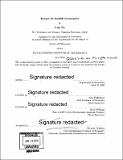| dc.contributor.advisor | Amy Finkelstein and Heidi Williams. | en_US |
| dc.contributor.author | Wu, Yufei, Ph. D. Massachusetts Institute of Technology | en_US |
| dc.contributor.other | Massachusetts Institute of Technology. Department of Economics. | en_US |
| dc.date.accessioned | 2016-09-30T19:38:43Z | |
| dc.date.available | 2016-09-30T19:38:43Z | |
| dc.date.issued | 2016 | en_US |
| dc.identifier.uri | http://hdl.handle.net/1721.1/104619 | |
| dc.description | Thesis: Ph. D., Massachusetts Institute of Technology, Department of Economics, 2016. | en_US |
| dc.description | "June 2016." Cataloged from PDF version of thesis. | en_US |
| dc.description | Includes bibliographical references (pages 135-144). | en_US |
| dc.description.abstract | The first chapter explores strategic insurer pricing in response to consumer inertia. A growing literature has documented evidence that consumers in health insurance markets are inertial, or behave as though they face substantial switching costs in choosing a health insurance plan. I investigate whether the private firms that provide prescription drug insurance through Medicare Part D exploit this inertia when setting prices. I first document descriptive evidence consistent with insurers initially setting low prices in order to "invest" in future demand before later raising prices to "harvest" inertial consumers. I then apply a two-step estimation approach following Bajari, Benkard and Levin (2007) to explore the implications of these invest and harvest incentives for equilibrium pricing, finding that on net, demand inertia reduces equilibrium prices (i.e. the invest incentive dominates the harvest incentive). Finally, I evaluate welfare consequences of policies that could be used to constrain insurers' ability to conduct such "invest-then-harvest" pricing patterns. I find, for example, that a policy change to cap premium increases would improve consumer welfare by both lowering average premiums and smoothing prices over time. Motivated by prior work on market size spurring innovation, the second chapter (co-authored with Manuel Hermosilla) explores the role of increased downstream demand in facilitating interfirm cooperation in the pharmaceutical industry, where licensing is a common form of collaboration between upstream innovators and downstream commercializers. We propose a simple model of licensing with heterogeneous match quality which predicts that positive demand shocks will increase the likelihood of licensing and improve match quality by reducing the relative importance of transaction costs. We then use the differential impacts of the introduction of Medicare Part D across drug categories 'targeting different ages of consumers as a source of variation in demand, and document empirical evidence consistent with the model. Using US county-level data on physician stock from the Area Resource File, the third chapter is devoted to uncovering and understanding the differential effects of medical schools on the supply of physician across regions. I use a difference-in-difference framework to compare changes in physician supply in areas closer to new medical school entries with regions further away. I find that a new medical school increased the physician supply by one to three times the county average level in the county where the medical school was located, relative to other counties. The broader regional effect was smaller but still substantial - a new medical school increased physician supply by one fourth to two thirds of the sample average in counties within 50 miles, relative to counties farther away. When tracking the effect over time, I find that a new medical school had the same impact in the year of entry and in the following 20 years, which indicates that most of the impacts could be attributed to the immediate responses. I find no effect on the physician supply in most of the pre-entry years, which supports the identifying assumption that locations of new medical schools were not correlated with other underlying determinants of physician supply. | en_US |
| dc.description.statementofresponsibility | by Yufei Wu. | en_US |
| dc.description.tableofcontents | Supply response to consumer inertia: strategic pricing in Medicare Part D -- Market size and innovation: the intermediary role of technology licensing -- Regional impacts of new medical school entries on the supply of physicians. | en_US |
| dc.format.extent | 144 pages | en_US |
| dc.language.iso | eng | en_US |
| dc.publisher | Massachusetts Institute of Technology | en_US |
| dc.rights | M.I.T. theses are protected by copyright. They may be viewed from this source for any purpose, but reproduction or distribution in any format is prohibited without written permission. See provided URL for inquiries about permission. | en_US |
| dc.rights.uri | http://dspace.mit.edu/handle/1721.1/7582 | en_US |
| dc.subject | Economics. | en_US |
| dc.title | Essays on health economics | en_US |
| dc.type | Thesis | en_US |
| dc.description.degree | Ph. D. | en_US |
| dc.contributor.department | Massachusetts Institute of Technology. Department of Economics | |
| dc.identifier.oclc | 959241129 | en_US |
